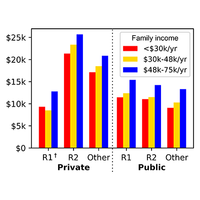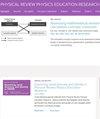Disparities in access to U.S. quantum information education
IF 3.6
2区 教育学
Q1 EDUCATION & EDUCATIONAL RESEARCH
Physical Review Physics Education Research
Pub Date : 2024-05-02
DOI:10.1103/physrevphyseducres.20.010131
引用次数: 0
Abstract
Driven in large part by the National Quantum Initiative Act of 2018, quantum information science (QIS) coursework and degree programs are rapidly spreading across U.S. institutions. Yet prior work suggests that access to quantum workforce education is unequally distributed, disproportionately benefiting students at private research-focused institutions whose student bodies are unrepresentative of U.S. higher education as a whole. We use regression analysis to analyze the distribution of QIS coursework across 456 institutions of higher learning as of Fall 2022, identifying statistically significant disparities across institutions in particular along the axes of institution classification, funding, and geographic distribution suggesting today’s QIS education programs are largely failing to reach low-income and rural students. We also conduct a brief analysis of the distribution of emerging dedicated QIS degree programs, discovering much the same trends. We conclude with a discussion of implications for educators, policymakers, and education researchers including specific policy recommendations to direct investments in QIS education to schools serving low-income and rural students, leverage existing grassroots diversity and inclusion initiatives that have arisen within the quantum community, and update and modernize procedures for collecting QIS educational data to better track these trends.

接受美国量子信息教育的差距
在 2018 年《国家量子计划法案》的推动下,量子信息科学(QIS)课程和学位项目正在美国各院校迅速普及。然而,此前的研究表明,量子劳动力教育的分布并不均衡,私立研究型院校的学生受益过多,而这些院校的学生群体并不能代表美国高等教育的整体情况。我们使用回归分析法分析了截至 2022 年秋季 456 所高等院校的 QIS 课程分布情况,发现各院校在统计上存在显著差异,特别是在院校分类、资金和地理分布轴上,这表明当今的 QIS 教育项目在很大程度上未能惠及低收入和农村学生。我们还对新兴的专门的素质与创新教育学位项目的分布情况进行了简要分析,发现了大致相同的趋势。最后,我们讨论了对教育工作者、政策制定者和教育研究者的启示,包括具体的政策建议,即把对优质国际学校教育的投资引向为低收入和农村学生服务的学校,利用量子社区内出现的现有基层多样性和包容性倡议,更新优质国际学校教育数据的收集程序并使之现代化,以更好地跟踪这些趋势。
本文章由计算机程序翻译,如有差异,请以英文原文为准。
求助全文
约1分钟内获得全文
求助全文
来源期刊

Physical Review Physics Education Research
Social Sciences-Education
CiteScore
5.70
自引率
41.90%
发文量
84
审稿时长
32 weeks
期刊介绍:
PRPER covers all educational levels, from elementary through graduate education. All topics in experimental and theoretical physics education research are accepted, including, but not limited to:
Educational policy
Instructional strategies, and materials development
Research methodology
Epistemology, attitudes, and beliefs
Learning environment
Scientific reasoning and problem solving
Diversity and inclusion
Learning theory
Student participation
Faculty and teacher professional development
 求助内容:
求助内容: 应助结果提醒方式:
应助结果提醒方式:


